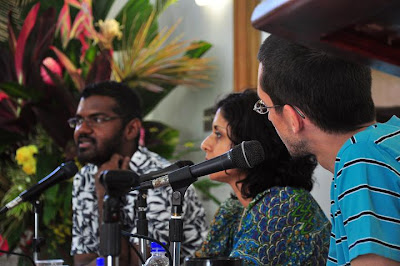What is Caribbean art?: why we need art history, a discussion at the 2012 Bocas Lit Fest
*
WHO AND what is art for? Is art meant to be seen or experienced? Who is the intended audience? Do artists make work just for the sake of the work; for themselves or for others? Do artists create for a country or a region or an even broader audience? Do they imagine their work speaking to others, speaking after death?
We have to pose these questions when we address another: what is the importance of preserving Caribbean art? (And, by the way, what is Caribbean art?)
A special panel discussion put on at the recent Bocas Lit Fest at the Old Fire Station Building in Port of Spain addressed the question of the need for art history. The panel, chaired by editor Nicholas Laughlin, included co-author of
Art in the Caribbean, Anne Walmsley, artist Christopher Cozier, art teacher Andy Jacob, and cultural studies lecturer Marsha Pearce.
Walmsley spoke about the process of putting together
Art in the Caribbean: An Introduction, which she co-authored with artist Stanley Greaves.
"The book is an attempt at chronicling the region's art," she said. "But it is not art history as art history is practicised today. It is a chance to look at work in different ways. I tried to find out more about the artists and their backgrounds. I found there was very little published material at the time." The idea behind the book was to be a kind of gallery or showcase.
"We would have a collection of images in a gallery in a book of reproductions with text alongside each: a visual anthology," she said. "We were very aware that it must be a regional book. It had to be regional. I was aware that we just did not know enough about art in the region. The Caribbean is--to use Christopher Cozier's phrase--an imaginary space. The work is all made here, even though some of the artists work abroad." With so much ground to cover, however, there were challenges.
"The actual selection was incredibly difficult," Walmsley said. "We had to pick work of quality that would repay close study." And work which was also in a form available for publication.
Pearce argued that the book presents a multi-faceted view, like looking through the lense of an insect's "compound eye".
"What you get is a mosaic," she said. "There is not only one lens. I feel that this book attempts that kind of mosaic." At a recap of the discussion
published at art magazine ARC's website, she calls for, "a compound way of seeing the Caribbean in relation to artistic practice."
 |
| Christopher Cozier, Anne Walmsley and Nicholas Laughlin. Photo by Andre Bagoo. |
"A compound eye is that which is made up of many, separate visual receptors.," Pearce writes. "Each receptor has its own lens and each lens catches its own image. A compound eye gives rise to a mosaic image. The more lenses the compound eye has, the higher the resolution or detail of the mosaic image. This compound way of seeing is critical for a space like the Caribbean, which we cannot hope to see and understand with one lens or in a stereoscopic way. Lenses are required in Curacao, St Vincent, Haiti; lenses must be focused in each of the various islands and anywhere else Caribbean people may find themselves: in Asia, in Africa, in Europe, in Brooklyn, in Melbourne. The mosaic image is a re-membering of the various lenses. A compound way of seeing can give us a higher resolution image of what a category, which we might call Caribbean art, looks like." Laughlin also noted that, "No single book is ever definitive."
There was discussion on the possibilities of the internet as providing a digital archive and the differences between seeing work in person, on the printed page and online. Cozier suggests that the internet opens up possibilities and takes on a life of its own.
"All artists are very concerned about the context of how their work is conveyed," he said. "The internet has changed everything. It allows all kinds of secondary genres: it becomes a parallel reality to the physical world." Pearce suggests that web archives address the inaccessibility of regional art.
"There is a glaring invisibility of art-work in the region for students. Students were not aware of art beyond Trinidad and Tobago. There is a need for students to know." Jacob saw no difference between the internet as a medium and printed forms.
"The difference between books and the internet is not that significant," he argued. "I don't think there is anything that is inherently different from the internet and the printed page."
*
SEE more
here.
Art in the Caribbean (New Beacon Books, 2010)





































